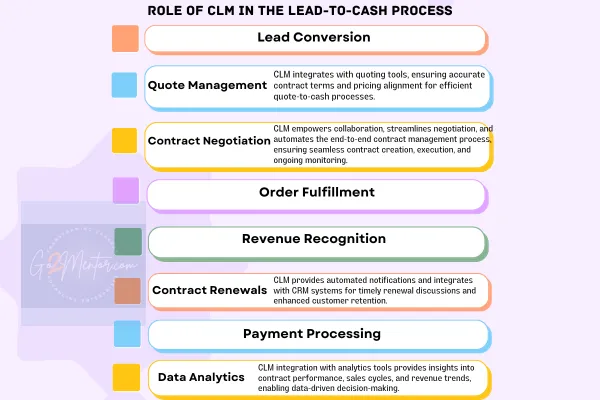
Streamlining the Lead to Cash Process with Contract Lifecycle Management (CLM)
Greetings & Welcome to our newsletter!
In this edition, we're thrilled to offer you valuable insights into how Contract Lifecycle Management (CLM) plays a crucial role in the Lead to Cash process. Effective contract management becomes paramount as businesses strive to generate leads, close deals, and maximize revenue. This edition will explore how CLM revolutionizes the Lead to Cash process by streamlining contract management and optimizing revenue generation.
The Lead to Cash process is vital for a business's success, involving everything from finding potential customers to closing deals and generating revenue. However, managing contracts effectively within this process can take time and effort, leading to delays, errors, and missed opportunities. Contract Lifecycle Management (CLM) is essential in this context.
Businesses can benefit significantly from Contract Lifecycle Management (CLM). It offers a structured approach to the entire lifecycle of a contract, from creation to renewal or termination. Organizations that incorporate contract lifecycle management as a part of their lead-to-cash process can reap several benefits, including enhanced visibility, reduced risk, and increased efficiency.
Understanding the Lead to Cash Process:
The Lead to Cash process consists of multiple linked stages, such as lead generation, opportunity management, quote creation, contract negotiation, order management, fulfillment, payments, and revenue recognition. Each stage has challenges, such as manual contract creation, inefficient negotiation processes, and lack of visibility into contract status. Contracts play a significant role in this process. Using manual methods to handle contracts, agreements, and terminations can cause delays and errors, severely impacting the entire lead-to-cash process.
The Role of Contract Lifecycle Management (CLM):
In the Lead To Cash process, Contract Lifecycle Management (CLM) is vital for efficient contract management. The CLM solution simplifies the contract process by serving as a central hub. It manages contract-related tasks from creation through renewal. This system is beneficial for managing the entire lifecycle of a contract, including creation, execution, renewal, and amendment. It allows for central storage of all related documents, making organizing and locating them easier. Using CLM, businesses can improve efficiency, compliance, risk management, and revenue optimization within their Lead to Cash process.
Managing Risk Through Contract Lifecycle Management (CLM) in the Lead to Cash Process:
Contract Lifecycle Management (CLM) solutions help businesses identify and mitigate any risks associated with the Lead To Cash process by providing an integrated compliance and risk management system. Contracts form the basis of all business dealings, and organizations need an effective and efficient management approach. The CLM solution allows companies to monitor and track their contracts, ensuring they comply with all relevant laws and regulations. It also helps businesses identify potential risks arising from an agreement, allowing them to address them before they become an issue.
CLM integration in the Lead to Cash Process:
Contract Lifecycle Management (CLM) extends the CRM and CPQ capabilities. It provides a centralized repository for the entire contract lifecycle, including functionalities such as version controlling, redlining capabilities, approvals management and real-time analytics and reporting.

Some of the commonly used CLM software include:
Conga CLM
Icertis Contract Management
DocuSign CLM
Ironclad CLM
Key Features and Functionalities of CLM:
Contract Creation and Authoring: CLM enables the creation and authoring of contracts, providing templates, standardized clauses, and workflows to streamline the process.
Template Management: CLM allows for the management and maintenance of contract templates, ensuring consistency and compliance across contracts.
Workflow Automation: CLM automates contract workflows, such as review and approval processes, reducing manual tasks and improving efficiency.
Collaboration and Redlining: CLM facilitates stakeholder collaboration by allowing multiple users to review and edit contracts, using features like redlining and version control.
Contract Repository: CLM provides a centralized repository for storing and organizing contracts, making it easy to search, retrieve, and manage contract documents.
Electronic Signatures: CLM integrates with electronic signature solutions, enabling secure and legally binding electronic signing of contracts.
Notifications and Reminders: CLM sends automated notifications and reminders for critical contract milestones, such as expiration dates and renewal opportunities.
Contract Analytics and Reporting: CLM offers analytics and reporting capabilities to track contract performance, monitor key metrics, and gain insights for strategic decision-making.
Integration with Business Systems: CLM integrates with other business systems, such as CRM, CPQ and ERP, to ensure seamless data flow and synchronization across different processes.
Compliance and Risk Management: CLM helps organizations maintain compliance with regulations and contractual obligations, reducing legal risks and ensuring adherence to internal policies.
In conclusion, embracing Contract Lifecycle Management (CLM) in the Lead to Cash process is a strategic move for organizations seeking to optimize their contract management and drive business growth. By implementing CLM best practices and leveraging CLM solutions, businesses can streamline contract processes, enhance collaboration, reduce risk, and improve revenue generation. Organizations can unlock new opportunities and gain a competitive advantage in the market by effectively managing contracts throughout their lifecycle, which improves operational efficiency.
